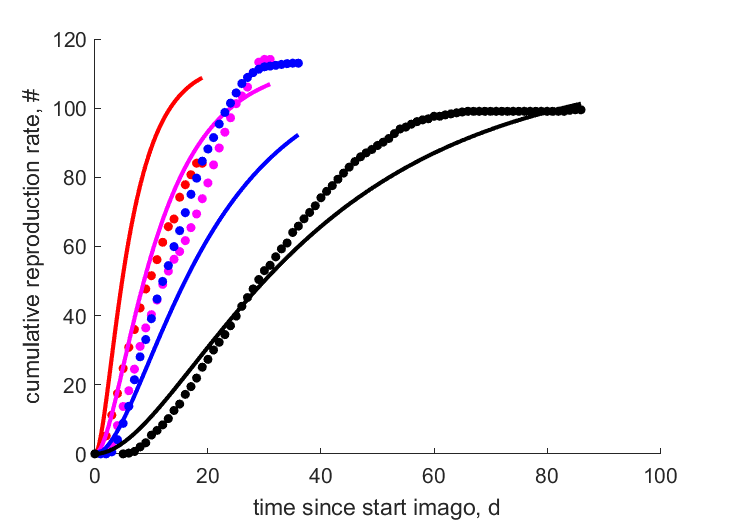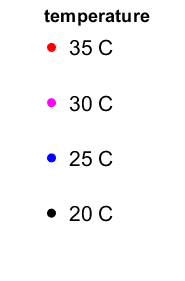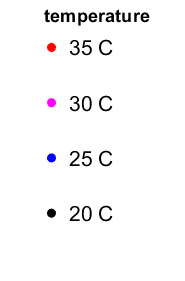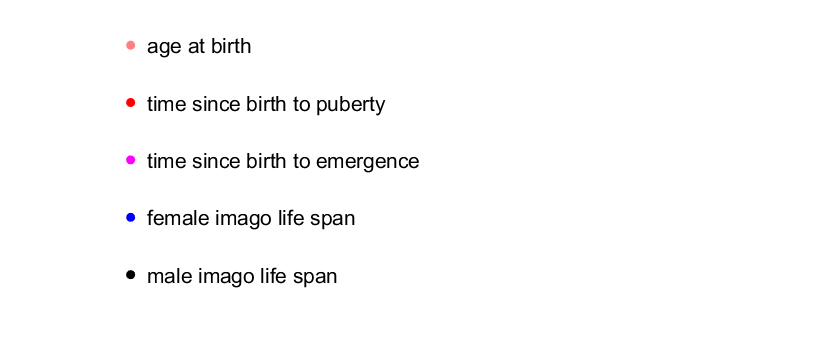Predictions & Data for this entry
| Model: hep | climate: A, C | migrate: | phylum: |
| COMPLETE = 3.2 | ecozone: TP | food: biHn, biCi | class: |
| MRE = 0.151 | habitat: biTh | gender: D | order: |
| SMSE = 0.129 | embryo: Thl | reprod: O | family: |
Zero-variate data
| Data | Observed | Predicted | (RE) | Unit | Description | Reference |
|---|---|---|---|---|---|---|
| Wwb | 3.7e-06 | 3.745e-06 | (0.01223) | g | wet weight at birth | guess |
| Wwj | 0.042 | 0.03797 | (0.09593) | g | wet weight female imago | guess |
| Wwjm | 0.034 | 0.03436 | (0.01047) | g | wet weight male imago | guess |
| Wwi | 0.0504 | 0.06841 | (0.3573) | g | asymptotic wet weight | guess |
| Ni | 115 | 113.5 | (0.01304) | # | total fecundity | SancLaca2002 |
Uni- and bivariate data
| Data | Figure | Independent variable | Dependent variable | (RE) | Reference |
|---|---|---|---|---|---|
| tN35 |   | time since start imago | cumulative reproduction rate | (0.5725) | SancLaca2002 |
| tN30 |   | time since start imago | cumulative reproduction rate | (0.1908) | SancLaca2002 |
| tN25 |   | time since start imago | cumulative reproduction rate | (0.2621) | SancLaca2002 |
| tN20 |   | time since start imago | cumulative reproduction rate | (0.08634) | SancLaca2002 |
| tS35 |   | time since start imago | surviving fraction | (0.1866) | SancLaca2002 |
| tS30 |   | time since start imago | surviving fraction | (0.1581) | SancLaca2002 |
| tS25 |   | time since start imago | surviving fraction | (0.1096) | SancLaca2002 |
| tS20 |   | time since start imago | surviving fraction | (0.1161) | SancLaca2002 |
| Tt_apji |   | temperature | duration | (0.2934) | SancLaca2002 |
Pseudo-data at Tref = 20°C
| Data | Generalised animal | Orius albidipennis | Unit | Description |
|---|---|---|---|---|
| v | 0.02 | 0.04804 | cm/d | energy conductance |
| p_M | 18 | 7718 | J/d.cm^3 | vol-spec som maint |
| k_J | 0.002 | 0.002 | 1/d | maturity maint rate coefficient |
| k | 0.3 | 0.001146 | - | maintenance ratio |
| kap | 0.8 | 0.915 | - | allocation fraction to soma |
| kap_G | 0.8 | 0.804 | - | growth efficiency |
| kap_R | 0.95 | 0.95 | - | reproduction efficiency |
Discussion
- males are supposed to differ from females by {p_Am} only
- model hep is applied: period bp acceleration, pe isomorphic growth, allocation to reprod, ei no growth or allocation to reprod
Facts
- Neonates count as instar 1, moult into instar 2 till 5, followed by the imago; so the period from birth to imago has 6 instar periods (Ref: Kopp2025)
Bibliography